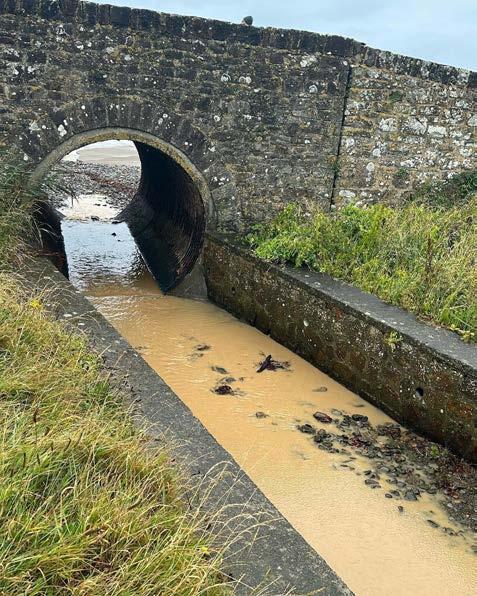
2 minute read
Broad Haven pollution alert
• Increased storm overflows eject sewage into seas, rivers and onto beaches
• Sewage outflow incidents increase dramatically
Advertisement
• Welsh Government says it cannot act
RECENT wet weather has drawn renewed attention to the scandal of sewage being dumped in rivers and beaches.
Following heavy rainfall over the last week and a half, the stream running across Broad Haven North’s beach was inundated with raw sewage from a storm overflow pipe that feeds into it.

As the crucial summer holiday season began, the stinking human waste caused local outrage and concern.
Raw sewage entered the sea in March from storm overflows at Manorbier, Wiseman’s Bridge, Saundersfoot, Tenby North Beach, and Newport.
Storm overflows that carry human waste into the rivers and onto Pembrokeshire’s beaches are symptomatic of an outdated water and sewage system not designed to cope with increased housing on or near watercourses and coastal areas or the increasing frequency of extreme weather events.
The rivers flowing into our coastal waters, chiefly the Cleddau and Teifi, are considered vulnerable to pollution and designated Sites of Special Scientific Interest (SSSI).
A combination of sewage and other contamination has damaged biodiversity in both rivers by disrupting the food chain.
As The Herald reported in June, the Western Cleddau has been contaminated by the outflow of wastewater from the First Milk Dairy in Merlin’s Bridge and the nearby sewage works. NRW continues to investigate.
Meanwhile, concerns about developments further downstream at Burton, including the capacity of the existing sewage system to cope with waste from planned new houses.
A river clean-up exercise along the Teifi near Cilgerran recovered significant amounts of agricultural trash (silage bags, etc.) and household rubbish dumped in the river.
A wastewater treatment plant in Cardigan spilt raw sewage into the Teifi on 304 days throughout 2022. Each spillage lasted for more than fifteen minutes.
The record of spillages relates to the Cilgerran and Llechryd pumping stations and the Cardigan wastewater treatment works. During winter, sewage entered the Teifi from sewage outflows from Welsh Water facilities almost daily.
The problem is not only the immediate sensory impact or shortterm environmental consequences of such pollution.
Polluted river waters and coastal outflows can suffer from “eutrophication”.
That means too many nutrients enter a watercourse, particularly nitrates and phosphates, and over-enrich its waters.
Consequently, waterways become clogged with weeds and algae that reduce the water’s oxygen, causing significant losses along the food chain and species loss.
In terms, rivers and coastal waters are suffocated to death.
The picture is worse in Pembrokeshire.
Pembrokeshire had the largest amount of sewage dumped into rivers, watercourses and beaches across England and Wales in 2021.

Pembrokeshire’s beaches had 6754 sewage dumps in 2021, lasting 79,501 hours.
Pembrokeshire’s Blue Flag beaches suffered 273 sewage dumps. Poppit Sands was the worst hit.
Seventy-nine sewage dumps lasted almost 1600 hours.
Coppet Hall Beach near Saundersfoot also suffered 79 dumps, totalling 1,294 hours.
Last week the Welsh Government’s regulator, Natural Resources Wales, downgraded Welsh Water’s performance.
The regulator has also been criticised for inaction.
This week, it announced the formation of a new task force to tackle agricultural pollution. However, agricultural pollution incidents are in long-term decline while pollution from antiquated water infrastructure increases.
The Welsh Government says it cannot interfere in running Welsh Water, which is ostensibly a not-for-profit private business. It’s thrown the responsibility onto Natural Resources Wales.
However, the Welsh Government’s priorities exclude giving NRW enough money and manpower to tackle Wales’s biggest polluter. Its decision to underfund NRW, a conscious policy choice, leaves the public and nature at the mercy of whatever Welsh Water decides to spend improving infrastructure and what a weak, underfunded regulator can do to bring it to heal.









